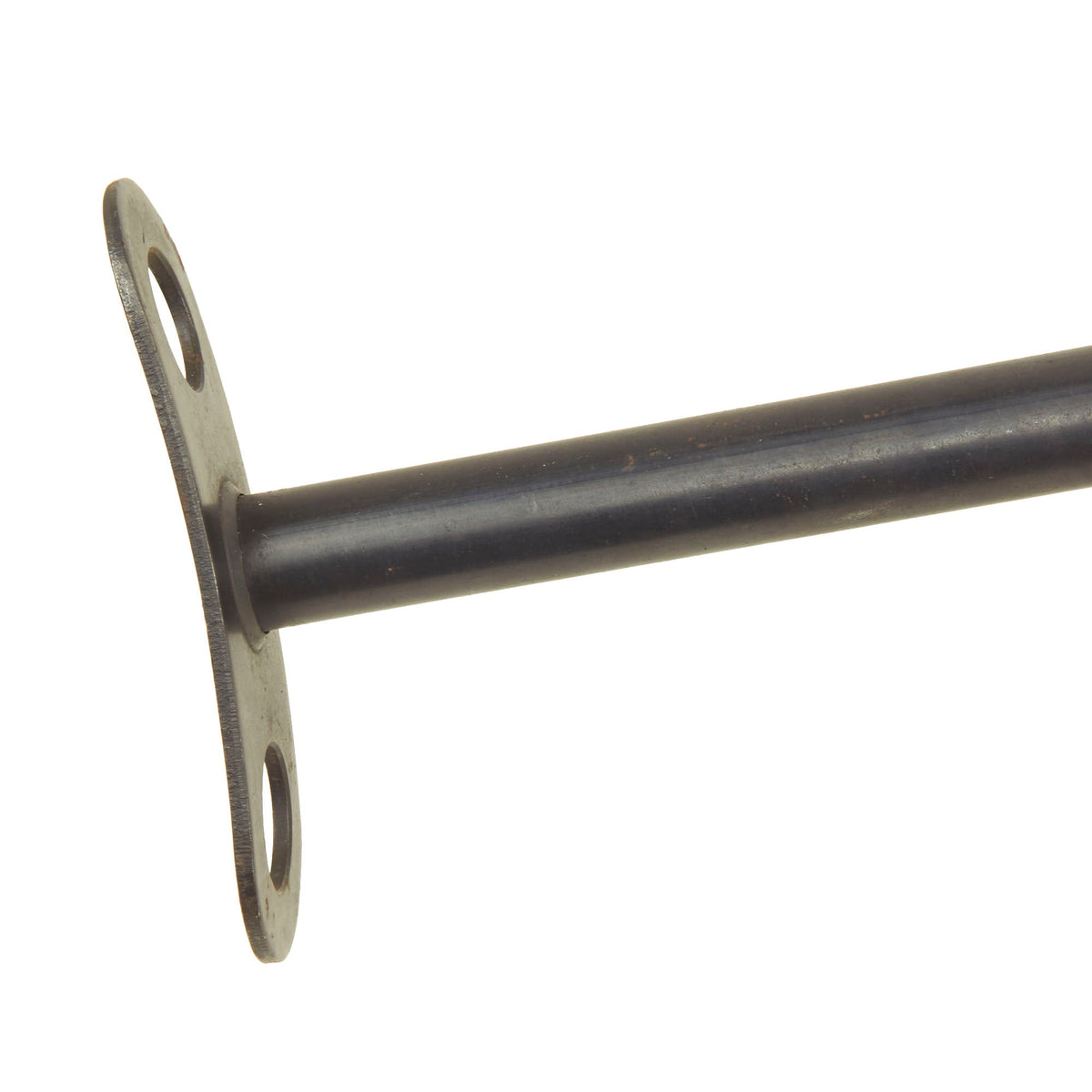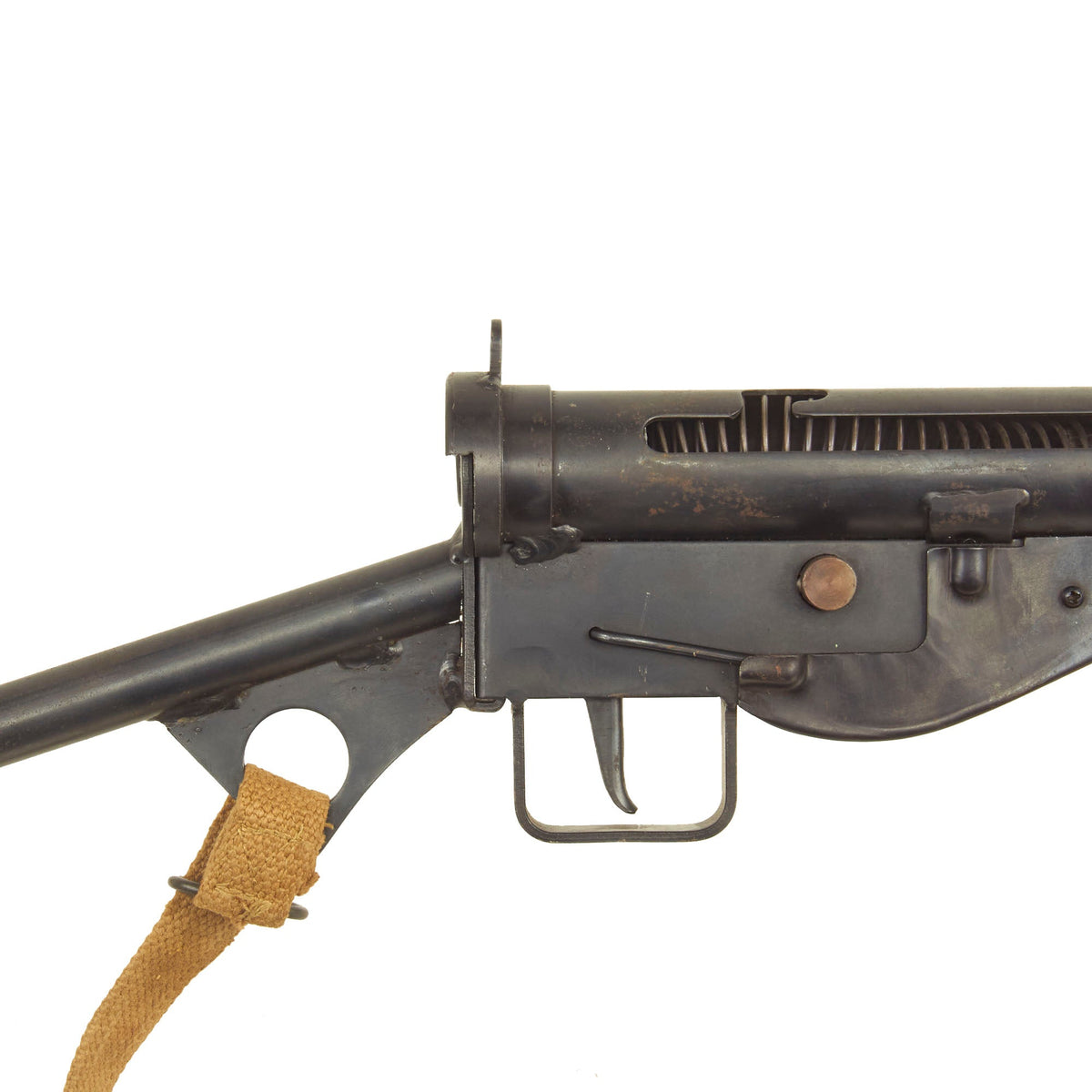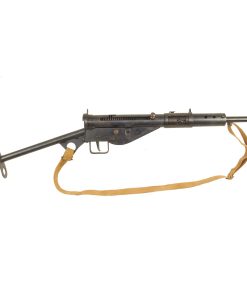Original British WWII Replica Sten MkII Cap Plug Firing Submachine Gun by MGC Japan with Sling Original Items
$ 795,00 $ 238,50
Vintage Replica Item: Only One Available. This is a fantastic extremely high quality British WWII STEN MkII “Plug Fire” replica gun, made by the well-known Model Gun Corporation (MGC) of Japan. These work with replica “cartridges”, which have small caps “plugged” into the front of them, which are then detonated by the replica bolt. These were ejected like real spent cartridges, and could be reloaded with additional caps. Sadly the plugs and caps have all been lost, probably long ago somewhere in a backyard. The original magazine was apparently lost as well, and a real STEN magazine is included, which will be deactivated where required.
As with the originals, the markings are on the magazine well:
STEN MK II
CMC NO A2448
JAPAN
This replica is really in great shape, and does not show many signs of use. The finish on the metalwork is in very good condition, and the only real area of finish loss is on the very end of the alloy barrel. An original unmarked khaki sling has been fitted, and is attached correctly.
This is a very nice replica and feels almost the same as the real thing! Great for reenactors and collectors alike.
All purchases are sent and need an adult signature which is required by UPS. Priority Mail is not available for this item. You must be 18 years old to purchase this model and 21 to sign for the package.
Not available for export or shipment to certain U.S. locations. Plug Fire ONLY. Cannot be converted to a functional weapon. Please read legal information for safety guidelines prior to purchasing.
Think of The Bridge on the River Kwai. William Holden holding his Sten and looking very grim. And how many other war movies do we remember where we remember the Sten but not the actors? Probably quite a few. Not only was the Sten ubiquitous in movies and among Allied troops, but the German Army, of all people, eventually made numerous copies of it. Earlier, Otto Skorzeny, the famous head of Germany’s equivalent of Britain’s Commandos, tried hard to get permission to use the silenced version of the Sten for his troops, but his request was rejected on grounds of national—read that as National Socialist—arrogance.
The Sten gun came about as a weapon of necessity, following the extremely large loss of small arms due to the Evacuation from the harbor of Dunkirk, France, May 26, 1940 – Jun 4, 1940. British / Forces were now engaged in the Battle of Britain, and needed replacement arms, and fast. The British did have access to Thompson machine guns from the U.S., but they were expensive and took time to procure. The MP28 Machine gun was one alternative, but also expensive. What the British needed was a gun that utilized mostly stamped components, which could be quickly and relatively cheaply made, but also be reliable.
The Royal Small Arms Factory, Enfield was commissioned to produce this alternative. The two designers were Major R. V. Shepherd, OBE, Inspector of Armaments in the Ministry of Supply Design Department at The Royal Arsenal, Woolwich, and Harold John Turpin, Senior Draughtsman of the Design Department of the Royal Small Arms Factory (RSAF), Enfield. They lent the first letters of their last names to the design, along with EN for Enfield, resulting in the STEN. There were several versions produced during the war, and it was the Sten MkII and MkIII that first came into prominence, with the more “upmarket” Sten MkV appearing later. However there were other designs before major production, as well as some intermediate designs, which were never made in large numbers, and never really left the prototype stage.
The original first model design, known as the Mark I, had a conical flash hider and fine finish. The foregrip, forward handle and some of the stock were made of wood. The stock consisted of a small tube, similar to the Mark II Canadian. A design choice that was only present on the Mark I was that the pistol grip could be rotated forward to make it easier to stow. 100,000 Mark I Stens were made before production was moved to the Mark II, however many of these were MkI* types, which did away with the wooden furniture, foregrip, and flash hider. The MkII simplified things further, with a simple loop butt stock and no wood of any kind. Later examples featured a “T” butt stock that was much more sturdy, a design carried on to the later MkIII sten.
Fast Shipping with Professional Packaging
Thanks to our longstanding association with UPS FedEx DHL, and other major international carriers, we are able to provide a range of shipping options. Our warehouse staff is expertly trained and will wrap your products according to our exact and precise specifications. Prior to shipping, your goods will be thoroughly examined and securely secured. We ship to thousands clients each day across multiple countries. This shows how we're dedicated to be the largest retailer on the internet. Warehouses and distribution centres can be located throughout Europe as well as the USA.
Note: Orders with more than one item will be assigned a processing date depending on the item.
Before shipping before shipping, we'll conduct a thorough inspection of the items you have ordered. Today, the majority of orders will be delivered within 48 hours. The delivery time will be between 3-7 days.
Returns
The stock is dynamic and we cannot completely manage it because multiple stakeholders are involved, including our factory and warehouse. So the actual stock may alter at any time. It's possible that you may not receive your order once the order has been made.
Our policy is valid for a period of 30 days. If you don't receive the product within 30 days, we are not able to issue a refund or an exchange.
You can only return an item if it is unused and in the same state as the day you received it. You must have the item in its original packaging.
Related products
Uncategorized
Uncategorized
Uncategorized
Uncategorized
Uncategorized
Uncategorized
Uncategorized
Uncategorized
Uncategorized
Armored Burgonet Helmet & Polearm from Scottish Castle Leith Hall Circa 1700 Original Items
Uncategorized
Uncategorized
Uncategorized
Uncategorized
Uncategorized
Uncategorized
Uncategorized
Uncategorized













































































